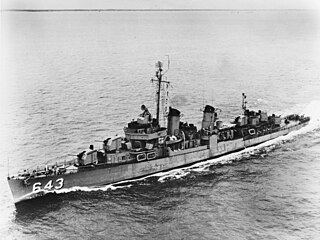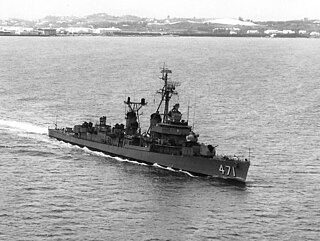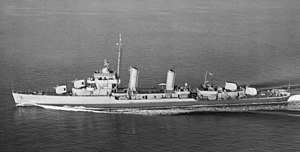
USS Abbot (DD-629) was a Fletcher-class destroyer in the service of the United States Navy. She was the second Navy ship named after Commodore Joel Abbot (1793–1855).

USS Abercrombie (DE-343) was a John C. Butler-class destroyer escort in the service of the United States Navy from 1944 to 1946. She was finally sunk as a target in 1968.

USS Franks (DD-554), a World War II-era Fletcher-class destroyer in the service of the United States Navy, was named after Medal of Honor recipient Acting Master's Mate William Joseph Franks.

USS Miller (DD-535) was a World War II-era Fletcher-class destroyer in the service of the United States Navy, named after Medal of Honor recipient Acting Master's Mate James Miller.

USS Trathen (DD-530) was a World War II-era Fletcher-class destroyer in the service of the United States Navy from 1943 to 1946 and 1951 to 1965.

USS Mugford (DD-389), a Bagley-class destroyer, was the 2nd ship of the United States Navy to be named for James Mugford, who commanded the schooner Franklin in the Continental Navy, serving through 1775.

USS Ralph Talbot (DD-390) was a Bagley-class destroyer in the United States Navy, named for USMC Second Lieutenant Ralph Talbot (1897–1918), who was awarded the Medal of Honor during World War I. Talbot served in the Pacific Theater during World War II, from the attack on Pearl Harbor through the battle of Okinawa, earning 14 battle stars for her service.

USS Sigourney (DD-643) was a Fletcher-class destroyer, the second ship of the United States Navy to be named for James Sigourney, an officer during the War of 1812.

USS Wedderburn (DD-684), was a Fletcher-class destroyer of the United States Navy.

USS Hutchins (DD-476), was a Fletcher-class destroyer, of the United States Navy named after Naval aviator Lieutenant Carlton B. Hutchins (1904–1938), who though mortally injured, was able to remain at the controls of his aircraft and allow his surviving crew to parachute to safety and was posthumously awarded the Medal of Honor.

USS Taylor (DD/DDE-468) was a Fletcher-class destroyer of the United States Navy, named for Rear Admiral William Rogers Taylor (1811–1889). She was laid down on 28 August 1941 at Bath, Maine, by the Bath Iron Works Corp.; launched on 7 June 1942, sponsored by Mrs. H. A. Baldridge; and commissioned on 28 August 1942 at the Charlestown Navy Yard near Boston, Mass.

USS Erben (DD-631), a Fletcher-class destroyer, was a ship of the United States Navy named for Rear Admiral Henry Erben (1832–1909).

USS Ammen (DD-527), a Fletcher-class destroyer, was the second ship of the United States Navy to be named for Rear Admiral Daniel Ammen (1820–1898).

USS Beale (DD/DDE-471), a Fletcher-class destroyer, was the second ship of the United States Navy to be named for Lieutenant Edward Fitzgerald Beale (1822–1893).

USS Stevens (DD-479) was a Fletcher-class destroyer in service with the United States Navy from 1943 to 1946. She was finally sold for scrap in 1973.

USS Anthony (DD-515), a Fletcher-class destroyer, was the second ship of the United States Navy to be named for Marine Sergeant Major William Anthony (1853–1899).

USS Robinson (DD-562), a Fletcher-class destroyer, was the second ship of the United States Navy to be named for Captain Isaiah Robinson, who served in the Continental Navy.

USS Patterson (DD-392), a Bagley-class destroyer, was the second ship of the United States Navy to be named for Daniel Todd Patterson, an officer of the US Navy who served in the Quasi-War with France, First Barbary War, and the War of 1812.

USS Harrison (DD-573) was a Fletcher-class destroyer of the United States Navy. She was second Navy ship of that name.

USS Dashiell (DD-659) was a Fletcher-class destroyer of the United States Navy, named for Robert B. Dashiell (1860–1899).




















